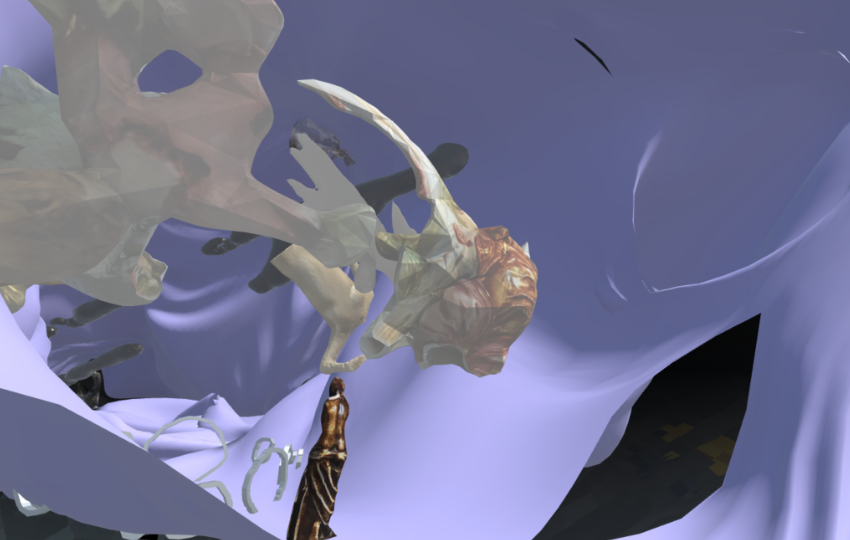Science, art and virtual reality weave together to reveal an unfamiliar and unsettling world
Sarah Gillett’s Not only; but also, a web-based artwork currently available online via Fermynwoods Contemporary Arts’ website, is a disorienting and strange place. Situated in mid-air within the grounds of a digitally rendered Rockingham Castle (a former royal castle and hunting lodge in Northamptonshire), the body of an unidentified woman is seen lying in repose, shrouded in a purple dress. The interior of her headless body is the site of Gillett’s constructed world, a place we are invited to navigate with our chosen avatar. The work is part video game, part virtual reality experience. Accompanied by the sounds of Gillett’s rewritten version of Clara H. Scott’s haunting 1895 hymn Open My Eyes, That I May See – a hymn used to begin seances at Rockingham Castle in the 1930s – our time spent in Gillett’s world is unsettling. Yet this is a digital realm where there isn’t that much to actually see.
The work is based on the figure of the Anatomical Venus, an unsettlingly lifelike waxwork of a recumbent woman first realised around 1781 by master waxwork artist Clemente Susini, and Gillett’s interests lie in the body’s internal space. At the time, Susini’s work was both an aesthetic wonder and a scientific marvel, his intention to create a figure on which dissections could be carried out free of the stench of a decaying human body. Susini’s Anatomical Venus, human only in appearance, was also free of the existential characteristics so profoundly associated with being human; memories and thoughts, scars and birthmarks.
As we venture inside Gillett’s own Anatomical Venus, organs have been replaced with inanimate objects. We can see the grounds of Rockingham Castle surrounding us, though we cannot explore them. Bounded by the edges of the body we are exploring, Gillett confines us to the limits of the body; the world seen around beyond unnavigable. On entering this world, we are dropped into the middle of a circle of stones. Opposite us stands the likeness of the Venus de Milo. Moving through the world, we discover other objects: a millefiori paperweight, its once delicate glass structure replaced by a dulled and muddy digital rendering, sits half-submerged in the folds of the purple landscape. We’re cautious in our exploration of this disconnected place. According to the artist’s text, each item has been taken from Gillett’s collection of historical curios, a selection of original and reproduced objects. When placed together, they are recast as windows onto a more intimate vision of who the artist is. As we pass by these objects, Gillett is trusting us with her own personal history.
Walking our avatar through the body of Gillett’s supine Venus, we remain constrained to a slow exploration of the digital crevasses and amorphous paths the artist has created, searching for nothing, but finding ourselves enveloped by the artist’s shrine to herself. We’re navigating a vessel that stores Gillett’s memories, blurring the line between the privacy of the internal body and the public forum created by setting the artwork in digital space.
Gillett has destabilised the space in which we consume art. Creating work designed exclusively for the internet implies, at least on the surface, a sense of increased accessibility. But we can’t interact with these objects, merely spectate. What Gillett has created here is not a video game. She has, instead, created a digital museum; a place purpose -built to house her historical curio collection.
This is a ritualistic space. It is one that is entirely habitable, a world which is both inside and outside of the real world. We might be inclined to see it as a place to escape to, but that is itself a false promise. Not only; but also is not our dwelling, but Gillett’s. We are only invited guests.
Sarah Gillett’s Not only: but also is presented by Fermynwoods Contemporary Arts, and can be accessed online here
This article is part of Remark, a new platform for art writing in the East Midlands by ArtReview in collaboration with BACKLIT. Read more here and sign up for the Remark newsletter here
